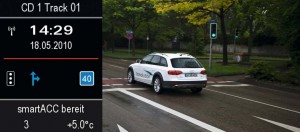Few things are more frustrating than bouncing from one red light to another when you’re doing your daily commute. Worse, every stop eats up fuel.
Enter Audi’s travolution concept, which uses WiFi-like technologies to link a car to the roadway infrastructure. As you’re traveling, the system is communicating with the stop lights along your route, finding out when they’re likely to go red or green.
That information can be displayed on a graph, much like today’s navigation systems show a countdown bar as you approach a turn. Except, in this case, travolution advises the motorist what the best speed would be to avoid hitting a red light. If you’re already at a stop, you’d be told how long before the light turns green again.
Syncing up traffic with the green-yellow-red sequence could significantly improve traffic flow, Audi officials contend. That would certainly help cool down frustrated motorists, but there’d be another, equally significant advantage.
With regulators around the world clamping down on fuel consumption and CO2 emissions, automaker like Audi are looking for every possible process to save a bit of petroleum. The German maker, a subsidiary of Volkswagen AG, estimates that a car using travolution would save about 0.02 liters of fuel for every stop it avoids. (For the metrically challenged, if you hit an average 10 lights a day while commuting, you’d save more than a gallon of gas a month.)
From a global warming perspective, Audi projects the travolution system would reduce CO2 consumption in urban applications by as much as 15%, or 2 million tons annually.
The travolution system would provide other services, as well. Since it’s designed to allow a car to communicate with the transportation infrastructure, it could permit a motorist to simply pull up to a gas pump or parking meter and not worry about having to use cash or a credit card. Could it also allow insurance companies to enact pay-as-you-go plans or allow state governments to tax a motorist according to miles driven?
Audi has begun testing the travolution system, which has been under development for several years, on 15 vehicles around its headquarters, in Ingollstadt. For the test, they’ll be able to communicate with 25 stoplights.

